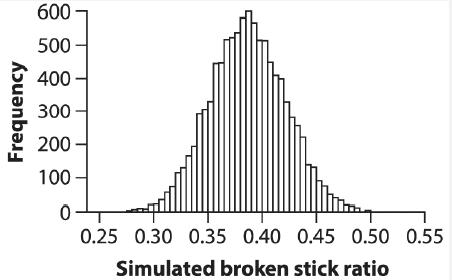The broken stick model is often used in ecology to represent how species should divide up space
Question:
The “broken stick” model is often used in ecology to represent how species should divide up space or resources if these are divided randomly. For example, Waldron (2007) compared the geographic range sizes of closely related bird species in North America. For each of 65 pairs of bird species, he used maps to calculate the total range sizes of the two species (in km2) , and then he calculated the ratio of the size of the smaller of the two ranges over the larger range size. This ratio can range from nearly zero, if one species of a pair has a much larger range than the other, to one, if both species have the same range sizes. He observed that the average ratio for all the pairs was 0.48. He then used simulation to test the null hypothesis that the mean of this ratio was no different than that expected if species divided the region “randomly” according to a randomly broken stick, with one species of every pair getting the short end and the other species the long end.
Using a computer, he took a stick of unit length, randomly broke it into two parts, and then calculated the ratio of the length of the smaller piece to the length of the larger piece. He did this 65 times, once for every pair of closely related species, and then took the average ratio. This process was repeated 10,000 times. The resulting 10,000 values for the ratio are shown in the accompanying graph.

a. What does this frequency distribution of simulated values for the ratio estimate?
b. Only 42 of the 10,000 simulated values for the ratio were greater than or equal to 0.48, the observed ratio in the bird data. Using this information, test the null hypothesis that the observed mean ratio of the bird range sizes is no different than expected if the species divided the region randomly as a broken stick.
Step by Step Answer:

The Analysis Of Biological Data
ISBN: 9781319226237
3rd Edition
Authors: Michael C. Whitlock, Dolph Schluter





